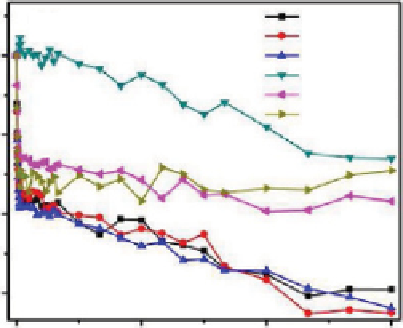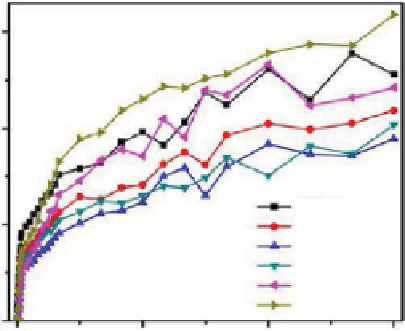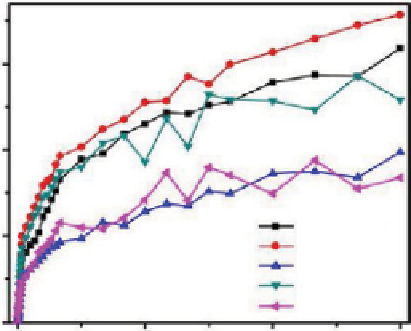Environmental Engineering Reference
In-Depth Information
PANI
0.1% Gra-10
0.5% Gra-10
1.0% Gra-10
3.0% Gra-10
5.0% Gra-10
30
0.0
20
-0.3
PANI
0.1% Gra-10
0.5% Gra-10
1.0% Gra-10
3.0% Gra-10
5.0% Gra-10
-0.6
10
290 K
-0.9
130 K
0
0
3
6
9
0
3 6
Magnetic eld (
T
)
9
Magnetic
eld (
T
)
0.3
5% Gra-10
5% Gra-40
5% Gra-P
5% CNFs
5% CNTs
30
0.0
20
-0.3
5% Gra-10
5% Gra-40
5% Gra-P
5% CNFs
5% CNTs
10
-0.6
130 K
290 K
0
9
0
3 6
Magnetic eld (
T
)
0
3 6
Magnetic eld (
T
)
9
figure 4.7
MR behavior of pure PANI and its PNCs as a function of Gra-10 loading at (a) 130 K and (b) 290 K; MR behavior of the PNCs
filled with 5% weight loading of different carbon nanostructures at (c) 130 K and (d) 290 K. Adapted with permission from Ref. [28]. © ACS.
parameters involved in the rheological analysis versus the oscillation frequency sweeping include complex viscosity (
η
*),
storage modulus (
G
′), loss modulus (
G
″), and damping property (tan
δ
). There are generally two major types of fluid behaviors:
the Newtonian frequency-independent fluid and the shear thinning fluid. Figure 4.8 shows an example of a PP-based nanocom-
posite where the PP matrix is doped with a small percentage of MA-grafted PP, with in situ synthesized cobalt NPs as nanofill-
ers. As is noted from the complex viscosity graph, the PP/PP-g-MA demonstrated Newtonian behavior at a lower frequency
range (below 1 Hz), while it showed apparent shear thinning behavior at a higher frequency range (between 1 and 100 Hz).
PNCs with relatively low-level nanofillers show similar behavior as the blend polymer matrix, while with high-level nanofillers,
the shear thinning phenomenon occurs throughout the whole frequency range.
4.4
environMental reMediation through Multifunctional nanocoMposites
Rapid industrialization has led to an increased discharge of wastes into the environment, posing potential harm to society and
human health. Among these are the heavy metal species found in underground and surface water, as well as the solid plastic
wastes accumulating in landfills and other locations.
Among these heavy metal species, Cr(vI) is a commonly identified contaminant because of its high toxicity and mobility
[30]. The maximum permissible limit of Cr in drinking water as recommended by the u.S. environmental Protection Agency
(ePA) is 100 µg/l [31]. Arsenic is also known for its toxicity and carcinogenicity to human beings [32-34]; drinking water con-
taminated with arsenic is becoming an increasingly significant concern throughout the world. long-term exposure to arsenic




